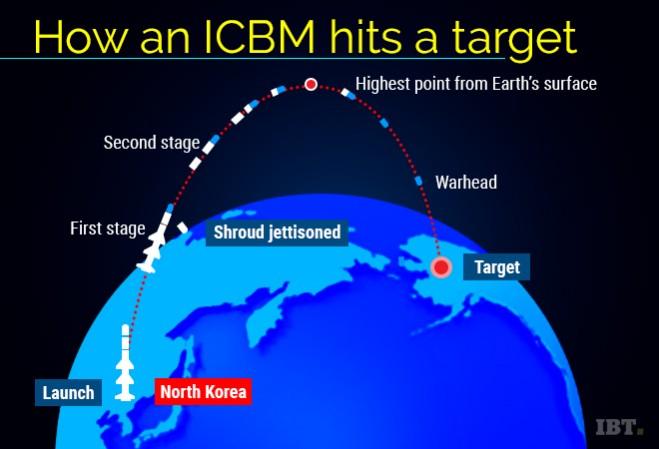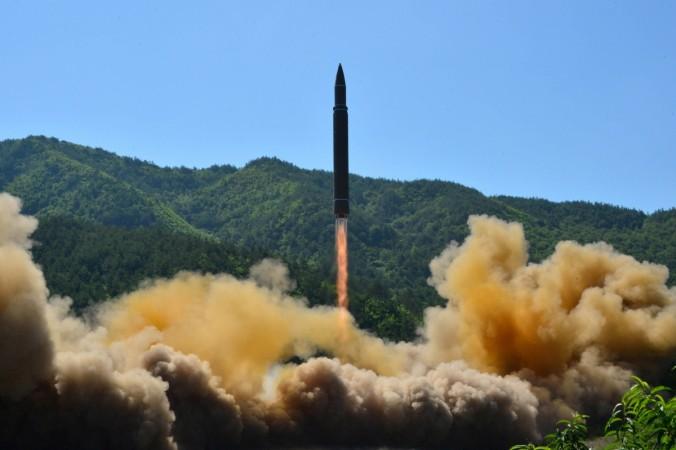The Pentagon's Defence Intelligence Agency (DIA) has warned in a new report that North Korea will have an intercontinental ballistic missile (ICBM) which can hit the United States with nuclear warhead as early as next year.
The latest assessment has significantly shrunk the timeline for when the US mainland could be struck by a nuclear-armed ICBM launched by Pyongyang, which was previously estimated to be at least three years away from having the capability.
The DIA report was apparently prompted by recent missile tests by North Korea, leading many to believe that the secluded nation has made serious progress at a remarkable pace in developing atomic weapons.
The US assessment of North Korea's ICBM programme is in line with predictions by South Korean intelligence officials, who have also warned of North Korea missiles that can hit targets thousands of miles away, the Washington Post reported.
The DIA assessment followed North Korea's July 4 test-fire of what it claimed was a long-range ICBM, which could potentially reach the US shores.

The Trump administration also confirmed North Korea's claim, with the US Pacific Command later concluding that the missile indeed had the range of an ICBM capable of hitting Alaska.
According to Scott Bray, the national intelligence manager for East Asia at the Office of the Director of National Intelligence, North Korea's recent test of an ICBM would help experts judge the threats the isolated regime poses to the US.
"This test, and its impact on our assessments, highlight the threat that North Korea's nuclear and ballistic missile programs pose to the United States, to our allies in the region, and to the whole world. The intelligence community is closely monitoring the expanding threat from North Korea," Bray told The Washington Post.
The DIA has now concluded that the North Korean leader Kim Jong Un will be able to produce a "reliable, nuclear-capable ICBM" programme sometime in 2018.
According to officials, the aggressive testing in recent months has helped the nation come up with basic designs before starting industrial production, which could be only a few months away.

Hwasong-14 startled the world
With the successful July 4 test of the ICBM, which was designated the "Hwasong-14," North Korea delivered a clear message to the world that it had mastered key technologies needed to launch a warhead towards far-off international targets.
On a range-maximising ballistic trajectory, the Hwasong-14's range could be as much as 7,000 km. If fired in an eastward direction to take advantage of the rotation of the Earth, the missile could reach up to 8,000 km.
The US government, on the other hand, reportedly assessed that the Hwasong-14's range could range between 7,000 and 9,500 km, allowing it to reach major US cities on the country's west coast, including Seattle, San Francisco, and Los Angeles.
Can the US defend against an ICBM?
The US military currently uses the Ground-based Midcourse Defence (GMD) system to defeat long-range missiles, such as the one that North Korea might launch to target the country.
According to the Centre for Strategic and International Studies (CSIS), an American think-tank, the GMD has had "a mixed but improving performance record over the course of two decades of testing."

In the most recent GMD test in May, a ground-based interceptor destroyed an ICBM-class target for the first time.
Following that, the Pentagon's weapons tester upgraded its assessment of the system's effectiveness, and declared that it had a "demonstrated capability to defend the US homeland from a small number of intermediate-range or intercontinental missile threats with simple countermeasures."
The CSIS, however, said in a recent report that the US still needs to modernise its interceptors, sensors, and ground systems to better defend against more powerful missile threats in the event of a nuclear war.

















